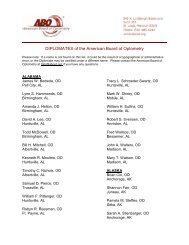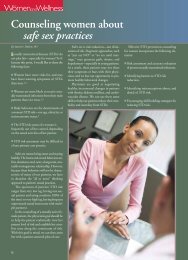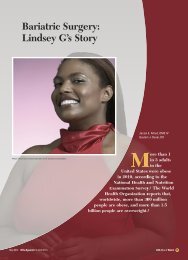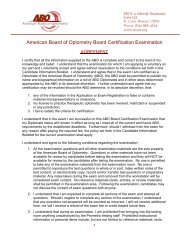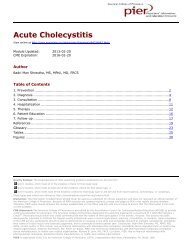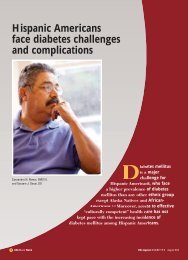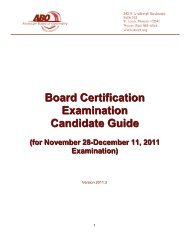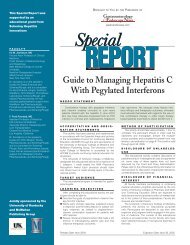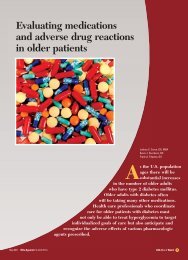Measles, mumps, and rubella: an adult concern - CECity
Measles, mumps, and rubella: an adult concern - CECity
Measles, mumps, and rubella: an adult concern - CECity
You also want an ePaper? Increase the reach of your titles
YUMPU automatically turns print PDFs into web optimized ePapers that Google loves.
<strong>Measles</strong>, <strong>mumps</strong>, <strong><strong>an</strong>d</strong> <strong>rubella</strong>:<br />
<strong>an</strong> <strong>adult</strong> <strong>concern</strong><br />
© Shutterstock.com<br />
St<strong>an</strong>ley E. Grogg, DO, FACOP, FAAP<br />
n 2011, there were<br />
222 cases of measles<br />
reported from 30 states.<br />
Eighty-eight percent (n=194) were<br />
import cases from 22 countries <strong><strong>an</strong>d</strong><br />
87% (n=191) were unvaccinated or had<br />
undocumented vaccine status. Seventeen<br />
measles outbreaks (defined as more th<strong>an</strong> 3<br />
cases linked in time <strong><strong>an</strong>d</strong> place) occurred in 2011.<br />
The Advisory Committee on Immunization Practices<br />
(ACIP) of the Centers for Disease Control <strong><strong>an</strong>d</strong> Prevention<br />
updated its 1998 <strong>Measles</strong>, Mumps, <strong><strong>an</strong>d</strong> Rubella (See Figure 1)<br />
(MMR) statement in 2012.<br />
March 2013 Improving <strong>adult</strong> immunization coverage AOA Health Watch 15
The 2013 ACIP MMR recommendation<br />
statements clarify the 1998 policy<br />
l<strong>an</strong>guage <strong><strong>an</strong>d</strong> include the following<br />
recommendations: 1,2<br />
1. Acceptable presumptive evidence<br />
of immunity.<br />
2. Vaccination of persons with HIV<br />
infection.<br />
3. Use of a third dose of MMR vaccine<br />
for <strong>mumps</strong> outbreaks.<br />
4. <strong>Measles</strong> postexposure prophylaxis.<br />
Acceptable presumptive<br />
evidence of immunity<br />
Acceptable evidence of immunity includes<br />
laboratory confirmation of measles <strong><strong>an</strong>d</strong><br />
<strong>mumps</strong>, rather th<strong>an</strong> a physici<strong>an</strong>’s diagnosis.<br />
Because of the rarity of measles <strong><strong>an</strong>d</strong> <strong>mumps</strong><br />
in the United States, with the exception of<br />
the recent endemics, ACIP believed that<br />
physici<strong>an</strong>s may confuse the symptoms of<br />
measles <strong><strong>an</strong>d</strong> <strong>mumps</strong> with other diseases<br />
<strong><strong>an</strong>d</strong>, thus, recommended laboratory<br />
confirmation as evidence of immunity.<br />
In addition, there are challenges with<br />
documenting history from physici<strong>an</strong> records<br />
for <strong>adult</strong>s. The new guidelines clarify that<br />
age-appropriate vaccination supersedes<br />
results of subsequent serologic testing.<br />
(For consistency with recommendations<br />
for health care personnel, the reader is<br />
referred to the following Morbidity <strong><strong>an</strong>d</strong><br />
Mortality Weekly Report article.) 3<br />
Vaccination of persons with hum<strong>an</strong><br />
immunodeficiency virus infection<br />
The current ACIP recommendations for<br />
persons with hum<strong>an</strong> immunodeficiency virus<br />
(HIV) infection are as follows: For children<br />
<strong><strong>an</strong>d</strong> adolescents with perinatal HIV infection<br />
who were vaccinated with measles, <strong>rubella</strong>-,<br />
or <strong>mumps</strong>-containing vaccine prior to the<br />
establishment of highly active <strong>an</strong>tiretroviral<br />
therapy (HAART) should be considered<br />
unvaccinated <strong><strong>an</strong>d</strong> should be revaccinated<br />
with 2 doses of MMR vaccine once effective<br />
HAART has been established (>6 months<br />
with CD4 percentage of >5%), unless they<br />
have other acceptable current evidence of<br />
measles, <strong>rubella</strong>, <strong><strong>an</strong>d</strong> <strong>mumps</strong> immunity.<br />
All family <strong><strong>an</strong>d</strong> other close contacts of<br />
immunocompromised persons should<br />
receive 2 doses of MMR vaccine, unless they<br />
have other evidence of measles immunity.<br />
Use of a third dose of MMR<br />
vaccine for <strong>mumps</strong> outbreaks<br />
During <strong>an</strong> epidemic of <strong>mumps</strong>, a third<br />
dose of MMR vaccine might be considered,<br />
according to ACIP. During recent <strong>mumps</strong><br />
outbreaks among populations with high rates<br />
of 2-dose vaccination, st<strong><strong>an</strong>d</strong>ard outbreak<br />
control measures have not prevented the<br />
continued spread of <strong>mumps</strong>. Giving the<br />
third dose of the MMR appears to provide<br />
<strong>an</strong> additional tool for outbreak control. A<br />
third dose of MMR vaccine may also be<br />
considered for health care personnel during<br />
<strong>mumps</strong> outbreaks, given the higher risk of<br />
exposure to disease <strong><strong>an</strong>d</strong> those at higher risk<br />
of complications. The routine use of a third<br />
dose of MMR vaccine is not recommended<br />
as part of the routine immunization schedule.<br />
<strong>Measles</strong> postexposure prophylaxis<br />
ACIP recommends the use of intramuscular<br />
immune globulin (IGIM) or intravenous<br />
immune globulin (IGIV) to unprotected<br />
persons exposed to measles. Due to the<br />
increased susceptibility at younger ages,<br />
ACIP recommends immune globulin<br />
(IG) for all inf<strong>an</strong>ts aged
Table 1. ACIP recommendations for measles,<br />
<strong>mumps</strong>, <strong><strong>an</strong>d</strong> <strong>rubella</strong> (MMR) vaccination<br />
MMR Vaccination Recommendations<br />
Persons born before 1957 generally are considered immune to measles <strong><strong>an</strong>d</strong> <strong>mumps</strong> <strong><strong>an</strong>d</strong> require<br />
vaccination only if <strong>an</strong>other risk factor is present. Health care personnel born before 1957 without<br />
evidence of MMR immunity or laboratory confirmation of disease should be vaccinated with<br />
2 doses of MMR vaccine for measles <strong><strong>an</strong>d</strong> <strong>mumps</strong> or 1 dose of MMR vaccine for <strong>rubella</strong>.<br />
Adults born during or after 1957 should have documentation of 1 or more doses of MMR vaccine<br />
unless they have a medical contraindication to the vaccine, laboratory evidence of immunity to each<br />
of the 3 diseases, or documentation of provider-diagnosed measles or <strong>mumps</strong> disease. For <strong>rubella</strong>,<br />
documentation of provider-diagnosed disease is not considered acceptable evidence of immunity.<br />
High-risk <strong>adult</strong>s should be vaccinated if they haven’t received their second dose of vaccine.<br />
At-risk groups include:<br />
students in postsecondary educational institutions<br />
health-care facility workers<br />
international travelers<br />
women of childbearing age (vaccinate during pre-pregn<strong>an</strong>cy or postpartum)<br />
Sources: ACIP Provisional Recommendations: Prevention of measles, <strong>rubella</strong>, congenital <strong>rubella</strong> syndrome (CRS), <strong><strong>an</strong>d</strong> <strong>mumps</strong>.<br />
http://www.cdc.gov/vaccines/recs/provisional/downloads/mmr-Oct-2012.pdf. Posted December 6, 2012.<br />
Maybe, but she could be tested for<br />
immunity. If the test indicates that<br />
she is not immune to 1 or more of the<br />
vaccine components, she should receive<br />
2 doses of MMR vaccine at least 4 weeks<br />
apart. ACIP does not recommend<br />
serologic testing after vaccination.<br />
Q: The HCP in question 3 on page 16 is<br />
given <strong>an</strong> MMR vaccination <strong><strong>an</strong>d</strong> develops a<br />
rash <strong><strong>an</strong>d</strong> a low-grade fever 10 days later. Is<br />
she infectious?<br />
No. Approximately 5%-15% of<br />
susceptible people who receive the MMR<br />
vaccination will develop a low-grade<br />
fever <strong><strong>an</strong>d</strong>/or mild rash 7-12 days after<br />
vaccination. The person is not infectious,<br />
<strong><strong>an</strong>d</strong> no special precautions (eg, exclusion<br />
from work) need to be taken.<br />
Q: A patient born in 1960, who has a history<br />
of receiving 1 dose of MMR vaccine as a<br />
child, pl<strong>an</strong>s to travel to Fr<strong>an</strong>ce soon. Should<br />
she be given a second dose of MMR?<br />
Yes. ACIP recommends a second dose of<br />
MMR vaccine for <strong>an</strong>y <strong>adult</strong> born during<br />
1957 or later who pl<strong>an</strong>s to travel<br />
internationally.<br />
Q: An unvaccinated 18-year-old was<br />
exposed to a child with measles. C<strong>an</strong> he be<br />
given <strong>an</strong> MMR dose to protect him from<br />
developing measles?<br />
Yes. <strong>Measles</strong> vaccine, given as MMR,<br />
may be effective if given within the first<br />
3 days (72 hours) after exposure to<br />
measles. IG may be effective for as long<br />
as 6 days after exposure.<br />
Q: A college student has no titer evidence<br />
of measles immunity. What type of vaccine<br />
should he receive?<br />
Single-<strong>an</strong>tigen vaccine is no longer<br />
available in the United States; therefore,<br />
the student should get the combined MMR<br />
vaccine. He should receive 2 doses of MMR<br />
vaccine separated by at least 1 month.<br />
Q: An <strong>adult</strong> female patient is going back to<br />
college <strong><strong>an</strong>d</strong> must show proof of MMR<br />
vaccination. She is unable to retrieve her<br />
immunization records. What appropriate<br />
options might be suggested?<br />
The options are to either vaccinate with<br />
the MMR vaccine or obtain serologic<br />
testing for all the <strong>an</strong>tigens for which<br />
documented immunity is required.<br />
Q: A 30-year-old m<strong>an</strong> needs a tuberculosis<br />
test <strong><strong>an</strong>d</strong> a dose of MMR. C<strong>an</strong> he be given a<br />
tuberculin skin test (TST) on the same day<br />
as a dose of MMR vaccine?<br />
Yes. A TST c<strong>an</strong> be applied before or<br />
on the same day that <strong>an</strong> MMR vaccination<br />
is given. However, if <strong>an</strong> MMR<br />
vaccine is given on the previous day or<br />
earlier, the TST should be delayed for at<br />
least 1 month. Live measles vaccine given<br />
prior to the application of a TST c<strong>an</strong><br />
reduce the reactivity of the skin test<br />
because of mild suppression of<br />
the immune system.<br />
Q: A 33-year-old patient is going back to<br />
college to complete her degree. She has a<br />
history of <strong>an</strong> “egg allergy.” C<strong>an</strong> she be given<br />
the MMR vaccination?<br />
Yes. Several studies have documented<br />
the safety of measles <strong><strong>an</strong>d</strong> <strong>mumps</strong> vaccine<br />
(which are grown in chick embryo tissue<br />
culture) in patients with severe egg<br />
allergy. Neither the “Red Book”<br />
Committee of the Americ<strong>an</strong> Academy of<br />
Pediatrics nor ACIP consider egg allergy<br />
as a contraindication to receiving the<br />
MMR vaccine.<br />
Q: And the No. 1 question that is asked:<br />
Does the MMR vaccination cause autism?<br />
No. This issue has been studied extensively<br />
in recent years, including a thorough<br />
review by the independent Institute of<br />
Medicine (IOM) of the National Academy<br />
of Sciences. The IOM issued a report in<br />
2004 that concluded there is no evidence<br />
supporting <strong>an</strong> association between MMR<br />
vaccine <strong><strong>an</strong>d</strong> autism. To access the IOM<br />
committee minutes, as well as the executive<br />
summaries <strong><strong>an</strong>d</strong> full reports, visit<br />
www.iom.edu/CMS/3793/4705.aspx.<br />
References<br />
1. Centers for Disease Control <strong><strong>an</strong>d</strong> Prevention (CDC).<br />
<strong>Measles</strong>—United States, 2011. MMWR Morb<br />
Mortal Wkly Rep. 2012;61:253-257.<br />
2. McLe<strong>an</strong> H. Proposed policy considerations<br />
pertaining to measles, <strong>mumps</strong>, <strong><strong>an</strong>d</strong> <strong>rubella</strong>. ACIP<br />
MMR 2012 Provisional Recommendations. Centers<br />
for Disease Control <strong><strong>an</strong>d</strong> Prevention Advisory<br />
Committee on Immunization Practices website.<br />
http://www.cdc.gov/vaccines/acip/meetings/downl<br />
oads/slides-jun-2012/04-MMR-McLe<strong>an</strong>.pdf.<br />
Accessed J<strong>an</strong>uary 12, 2013.<br />
3. Advisory Committee on Immunization Practices;<br />
Centers for Disease Control <strong><strong>an</strong>d</strong> Prevention (CDC).<br />
Immunization of health-care personnel:<br />
recommendations of the Advisory Committee on<br />
Immunization Practices (ACIP). MMWR Recomm<br />
Rep. 2011;60(RR-7):1-45.<br />
4. Immunization Action Coalition. CDC publishes<br />
provisional ACIP recommendations for prevention<br />
of measles, <strong>rubella</strong>, congenital <strong>rubella</strong> syndrome,<br />
<strong><strong>an</strong>d</strong> <strong>mumps</strong>. http://www.immunize.org/express/<br />
issue1030.asp#IACX2. Accessed J<strong>an</strong>uary 12, 2013.<br />
5. Immunization Action Coalition. Ask the experts:<br />
measles, <strong>mumps</strong>, <strong><strong>an</strong>d</strong> <strong>rubella</strong>—common questions<br />
about use of MMR. http://www.immunize.org/<br />
askexperts/experts_mmr.asp. Accessed<br />
J<strong>an</strong>uary 12, 2013. HW<br />
About the Author<br />
St<strong>an</strong>ley E. Grogg, DO, FACOP, FAAP is <strong>an</strong><br />
associate de<strong>an</strong> of clinical research <strong><strong>an</strong>d</strong><br />
professor of pediatrics at Oklahoma State<br />
University Center for Health Sciences College<br />
of Osteopathic Medicine in Tulsa. Dr. Grogg<br />
also serves as the Americ<strong>an</strong> Osteopathic<br />
Association’s representative to the Centers for<br />
Disease Control <strong><strong>an</strong>d</strong> Prevention’s Advisory<br />
Committee on Immunization Practices. Dr. Grogg<br />
c<strong>an</strong> be reached at St<strong>an</strong>ley.grogg@okstate.edu.<br />
March 2013<br />
Improving <strong>adult</strong> immunization coverage<br />
AOA Health Watch<br />
17



